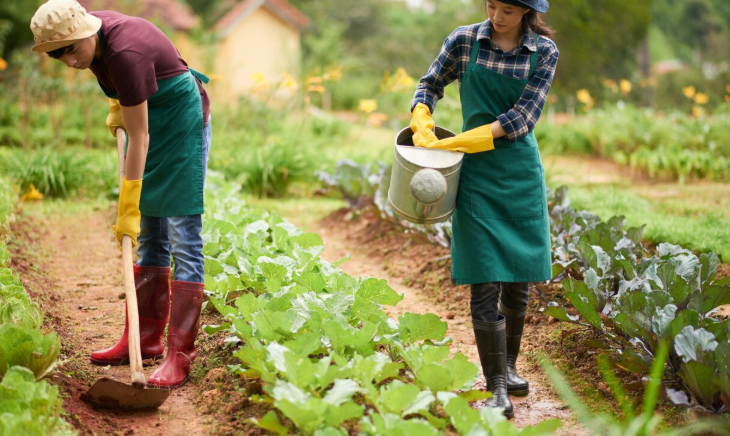For millennia, agriculture has been an art form painted with sweat, intuition, and the wisdom passed down through generations. But like any canvas, the fields where our food takes root are also primed for innovation. Precision agriculture, armed with the keen eye of data analytics and the steady hand of automation, is rapidly transforming traditional farming methods, rewriting the narrative of food production with strokes of efficiency, sustainability, and resilience. Let’s delve into the fertile soil of this transformation and explore how precision agriculture is reshaping the face of farming.

1. From Guesswork to Granularity: Data-Driven Decision Making
Traditionally, farmers relied on experience and broad estimates to manage their fields. Precision agriculture throws open the window on this opaque process, flooding it with the sunlight of data. Sensors embedded in the soil whisper secrets of moisture levels and nutrient deficiencies. Drones paint high-resolution portraits of crop health, and satellite imagery reveals hidden patterns in field conditions. This data deluge, once analyzed by sophisticated software, transforms into actionable insights, guiding farmers to make precise decisions at the field level, rather than relying on one-size-fits-all approaches.
2. Optimizing Inputs: Minimizing Waste, Maximizing Yield
Water, fertilizer, and pesticides are the lifeblood of traditional farming, but often applied with the blunt force of a broadsword. Precision agriculture replaces this approach with the finesse of a scalpel. Irrigation systems equipped with soil moisture sensors deliver water only where and when it’s needed, reducing waste by as much as 70%. Fertilizer application maps, meticulously crafted from soil analysis data, ensure nutrients reach deficient areas, reducing environmental impact and boosting crop yields by up to 25%. Precision spraying techniques target specific pests and diseases, protecting beneficial insects and minimizing chemical use.
3. Automation Takes the Wheel: From Backbreaking to Brainiac Farming
Imagine fields patrolled not by sun-baked farmers but by a fleet of tireless robotic assistants. Precision agriculture is making this vision a reality. Autonomous tractors, guided by GPS and AI algorithms, navigate tight rows with uncanny precision, planting seeds, weeding fields, and even harvesting crops. This not only reduces manual labor but also allows for 24/7 operation, maximizing efficiency and freeing up farmers’ time for strategic decision-making.
4. Climate-Smart Practices: Cultivating Harmony with the Environment
Traditional agriculture, with its reliance on intensive practices, can leave a hefty carbon footprint. Precision agriculture offers a path towards more sustainable food production. Techniques like cover cropping, which enriches soil and reduces water evaporation, are woven into the fabric of farm management. Precision irrigation minimizes water usage, and targeted pest control reduces reliance on harmful chemicals. These practices not only benefit the environment but also build resilience against the increasing threats of climate change.
5. Bridging the Digital Divide: Empowering Every Farmer
The transformative power of precision agriculture shouldn’t be reserved for the technologically advanced. The future of farming will prioritize data democratization, ensuring affordable access to sensors, software, and training for small-scale farmers and resource-constrained communities. Open-source data platforms, affordable sensor kits, and peer-to-peer learning initiatives will bridge the digital divide, empowering every farmer to become a steward of sustainable agriculture.
6. From Farm to Fork: Transparency and Traceability
The journey of our food from farm to fork can be shrouded in mystery. Precision agriculture brings greater transparency to the table through blockchain technology. This secure, distributed ledger tracks every step of a crop’s journey, from seed to supermarket shelf, ensuring food safety, ethical sourcing, and fair compensation for farmers. Consumers, empowered with this information, can make informed choices, supporting sustainable practices and building trust in the food system.
7. AI-Powered Insights: From Data Deluge to Actionable Wisdom
Data collected is useless unless translated into actionable knowledge. The future of precision agriculture will see the rise of sophisticated AI algorithms that sift through the data deluge, unearthing hidden patterns and predicting crop health with uncanny accuracy. These AI oracles will guide farmers with prescriptive recommendations, optimizing irrigation schedules, predicting pest outbreaks, and even suggesting the most profitable crops for specific microclimates.
8. The Human Touch: Balancing Technology with Tradition
Amidst the whirring robots and crunching numbers, it’s easy to forget the human element at the heart of agriculture. The future of precision agriculture will not be a sterile monoculture of technology. Instead, it will be a dance between the wisdom of generations and the precision of data-driven insights. Farmers will remain the conductors of this agricultural orchestra, using their experience and intuition to interpret data, make informed decisions, and adapt to unforeseen challenges. Precision agriculture offers a novel solution: vertical farming. Towering skyscrapers, bathed in LED sunlight and meticulously monitored by precision agriculture technology, sprout in urban centers, defying the limitations of sprawling farmland. These controlled environments, where crops grow hydroponically or aeroponically, offer year-round, sustainable food production regardless of weather or geographical limitations.
10. Gene Editing: Tailoring Crops for Tomorrow’s Challenges
Climate change, pests, and diseases pose formidable threats to food security. The future of precision agriculture might hold the solution in the precise language of gene editing. By carefully modifying plant genes, scientists can create crops that are drought-resistant, pest-proof, and even fortified with essential nutrients. These advancements, in conjunction with precision agriculture practices, could revolutionize food production, ensuring resilience and abundance in the face of a changing world.
Additional Resources
- How Has Precision Agriculture Transformed Traditional Farming Methods?
- Overcoming Challenges in Precision Farming Implementation: A Comprehensive Guide
- What is precision crop monitoring, and how does it work
- Precision Planting: Seeding Success for Maximum Yields
- Precision Fruit Orchards: Optimizing Growth for Quality Produce
- How Drones Are Revolutionizing Precision Agriculture
- Transforming Precision Agriculture Excellence With10 Key Technologies
- Supercharge 4 Ways Of Precision Agriculture Solutions
- Precision Farming 101: A Beginner’s Guide
- Precision Agriculture and Food Security: A Global Perspective
Categories
Latest Posts
FAQs:
What is precision agriculture?
Precision agriculture is a farming management concept that uses technology to observe, measure, and respond to variations in fields. It moves away from the traditional, uniform approach to farming and uses data to apply resources like water and fertilizers with pinpoint accuracy.
How does precision agriculture change decision-making for farmers?
Precision agriculture transforms decision-making from broad guesswork to data-driven insights. Instead of relying on intuition, farmers use data from sensors, drones, and satellites to make precise, evidence-based choices about irrigation, fertilization, and pest control for specific sections of a field.
How does precision agriculture help with sustainability?
Precision agriculture promotes sustainability by optimizing resource use. By delivering water and chemicals only where they are needed, it significantly reduces waste and minimizes environmental harm from runoff, leading to a smaller carbon footprint and more resilient land.
What is the role of automation in precision agriculture?
Automation plays a critical role by performing labor-intensive and repetitive tasks. Autonomous tractors and robots, guided by GPS and AI, can plant seeds, weed fields, and harvest crops with extreme precision, increasing efficiency and reducing manual labor.
How does precision agriculture optimize the use of water?
Precision agriculture optimizes water use through technologies like soil moisture sensors and variable-rate irrigation. These systems deliver water only when and where the soil indicates it is needed, which can lead to significant reductions in water consumption.
Does precision agriculture help farmers in a changing climate?
Yes, by providing data on weather patterns, soil health, and crop stress, precision agriculture helps farmers build resilience. It enables them to make proactive adjustments to their practices and choose crop varieties that can better withstand threats like drought or extreme weather.
How does precision agriculture bring more transparency to the food supply chain?
By using technologies like blockchain, precision agriculture can create a secure and transparent record of a crop’s journey from “farm to fork.” This allows consumers to trace their food’s origin, verify its safety, and learn about the sustainable practices used to grow it.
Is precision agriculture affordable for small farms?
While the initial investment can be high, the cost of technology is decreasing. Initiatives focused on data democratization, open-source software, and affordable sensor kits are helping to bridge the digital divide and make precision agriculture accessible to small-scale farmers.
How does AI contribute to precision agriculture?
AI and machine learning algorithms analyze the vast amount of data collected from the field. They can identify patterns, predict crop yields or disease outbreaks, and provide prescriptive recommendations, helping farmers make smarter and more profitable decisions.
How is precision agriculture related to vertical farming?
Precision agriculture is the core technology that makes vertical farming possible. It provides the meticulous, data-driven control needed to manage environmental factors like light, temperature, and nutrients in a controlled indoor environment, enabling sustainable, year-round food production in urban areas.


